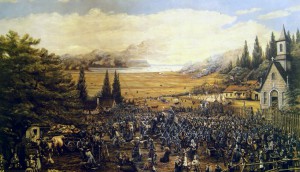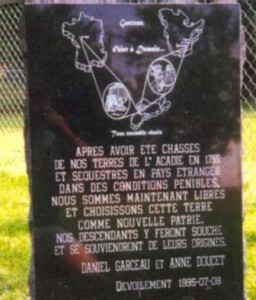Long before I started my own family research, there was one thing that I knew for certain: my Garceau line had a long history in Canada. After a great deal of research, I determined that my first ancestor to immigrate to Canada was a man named Jean Garceau, a French soldier who arrived at Port Royal, Annapolis County, Nova Scotia in the late seventeenth century.[1] I found that I was a descendant of his son, Daniel, born at Port Royal in 1707.[2] My research took an unexpected turn, however, when I found that many sources placed Daniel in Connecticut and then New York in the 1750s.[3] Why was Daniel in America?
It was then that I learned of an event known as 'The Great Expulsion,' which was the forced removal of 11,500 French settlers, known as Acadians. The term Acadian arose because the lands of present-day Nova Scotia, New Brunswick, Prince Edward Island, and parts of Quebec were known as Acadie.[4] Daniel, his wife, and his eight children were expelled on the ship Experiment and were left in Connecticut before making their way to New York.[5]
The British officially took control of Nova Scotia with the signing of the Treaty of Utrecht in 1713.[6] At this time, the British required the Acadians to take an unconditional oath of loyalty to the British Crown; many Acadians refused, and most signed neutrality agreements instead.[7] The difficulties with the British Crown were largely religious, as the King of Great Britain was the head of the Protestant Church of England and the Acadians were largely Roman Catholic.[8] Daniel Garceau signed an Oath of Allegiance, possibly under duress, on December 1729 that read (translated from the original French):
I sincerely promise and swear by the Christian faith that I will be completely faithful and truly obey His Majesty the King George the Second, who I acknowledge to be the Sovereign Lord of Nova Scotia or Acadia. So God help me.[9]
Acadian neutrality was not long-lasting. During the French and Indian War, the British viewed the Acadians and their allegiance to the French as a major threat.[10] The 1755 Bay of Fundy Campaign resulted in the beginning of the expulsion of Acadians by the British. After much resistance and many attempts to avoid expulsion, nearly 11,500 Acadians were driven out of Nova Scotia. The Acadians were sent to North American coastal colonies, where they formed small, impoverished Catholic communities. Three thousand five hundred Acadians were deported to France as well, making it the destination with the highest number of exiles.[11]
After living in the homes forced upon them by the British for years, or even decades, many Acadians returned to Canada, with some settling in Quebec, forming the large French Canadian population that exists there today. Many more returned to other Canadian maritime provinces such as New Brunswick. Others remained in their newly-established homes. By 1800, more than 4,000 Acadians had settled in Southwestern Louisiana, forming the basis for the modern Cajun population.[12]
More than 12 years after being expelled from Nova Scotia, Daniel Garceau returned to Canada, this time settling at Yamachiche, Quebec.[13] While Daniel's time in America was relatively brief, it still formed a pivotal part of my family's narrative. Today, a monument stands at Yamachiche dedicated to Daniel Garceau and his wife, Anne Doucet, which commemorates their expulsion and return to Canada.[14]
Notes
[1] Famille Garceau, http://www.famillegarceau.com/daniel_garceau.htm.
[2] François Pierre Sévère Lesieur Desaulniers, Les vieilles familles d’Yanmachiche (Montréal: C.O. Beauchemin & Fils, 1898-1908), p. 42.
[3] Ibid.
[4] Map of Acadia, courtesy of British Battles, http://www.britishbattles.com/french-indian/braddock-monongahela-part-1.htm.
[5] Acadians in New York, http://www.acadian-home.org/acadians-new-york.html.
[6] Geoffrey Plank, An Unsettled Conquest: The British Campaign Against the Peoples of Acadia (Philadelphia: University of Pennsylvania Press, 2003), p. 91.
[7] Acadian History, http://www.acadian.org/history.html.
[8] Ibid.
[9] Public Archives of Canada, Report, vol. 2 (Ottawa: Maclean, Roger & Company, 1906), pp. 74-75.
[10] Richard Patrick Carstens, The Republic of Canada Almost (Bloomington, Ind.: Xlibris Corporation, 2013), p. 270.
[11] Elliott Robert Barkan, Immigrants in American History: Arrival, Adaptation, and Integration (Santa Barbara, Calif.: ABC-CLIO, 2013).
[12] John Mack Faragher, A Great and Noble Scheme: The Tragic Story of the Expulsion of the French Acadians from Their American Homeland (New York: W.W. Norton and Co., 2006).
[13] Desaulniers, Les vieilles familles d'Yanmachiche, p. 42.
[14] Famille Garceau Website [see Note 1].
Share this:
About Zachary Garceau
Zachary J. Garceau is a former researcher at the New England Historic Genealogical Society. He joined the research staff after receiving a Master's degree in Historical Studies with a concentration in Public History from the University of Maryland-Baltimore County and a B.A. in history from the University of Rhode Island. He was a member of the Research Services team from 2014 to 2018, and now works as a technical writer. Zachary also works as a freelance writer, specializing in Rhode Island history, sports history, and French Canadian genealogy.View all posts by Zachary Garceau →

